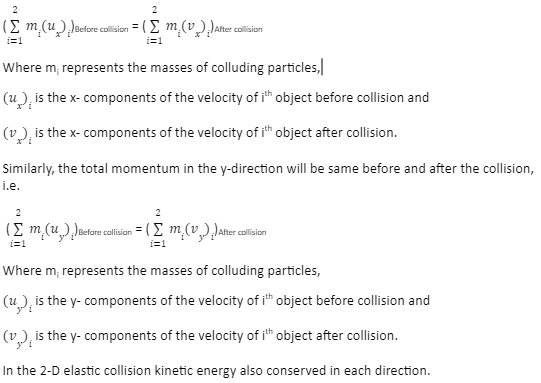In physics, collision is the direct contact between two bodies exerting force on each other in a short time. Examples include two billiard balls, a golf club and a ball, a hammer and a nail head, two train carriages when paired or a falling item and a floor. A collision results in the transfer of momentum or kinetic energy from one body to another. Collisions can be divided into two types: elastic and inelastic collisions. There can be an elastic collision in two dimensions and one dimension.
Definition of Elastic Collision
An elastic collision in physics is the interaction of two masses without any change in the total kinetic energy. In an ideal elastic collision, there is no net conversion of kinetic energy into other forms, such as heat, noise, or potential energy. For example, the molecules of ideal gases collide elastically. A gas comprises a large number of molecules that are elastic spheres. When these molecules are in Random or Brownian motion, they travel in diverse directions at speeds that vary from zero to infinity, obeying Newton’s equations of motion.
Elastic Collision in One Dimension
There are different types of two-object collisions. Elastic collision in one dimension is the simplest collision to study and it demonstrates many of the basic concepts involved in collisions.
In elastic collisions, the system does not suffer any net loss of kinetic energy and both momentum and kinetic energy remain unchanged. The conservation of momentum concept comes in handy as it can be applied whenever a system’s net external force is zero.
In one dimensional collision of two masses, the initial and final velocity of each of the masses lies in one line. And all the variables of motion are contained in a single dimension.
The total kinetic energy of the items in the system is the internal kinetic energy. Only subatomic particles, such as electrons colliding with nuclei, can rely on elastic collisions. Macroscopic collisions can be virtually elastic, but not totally. Some kinetic energy always gets transferred into other types of energy, such as heat and sound. The collision between two steel blocks of ice is an example of a virtually elastic macroscopic collision. Another virtually elastic collision occurs between two carts with spring bumpers on an air track. Icy surfaces and air tracks are practically frictionless, allowing nearly elastic impacts.
Perfectly elastic collisions are an ideal never fully achieved in the case of macroscopic substances. These can only be achieved with microscopic particles such as protons, electrons and neutrons. So, when calculating energies, consider the probable rotational energy before and after contact.
Elastic Collision in Two Dimensions
A two-dimensional collision or elastic collision in two dimensions follows the same laws as a one-dimensional collision. The total momentum in each direction and the total kinetic energy are always the same before and after the impact.
When two objects collide in two dimensions (e.g. x and y), momentum is preserved in each direction separately (as long as there is no external stimulus in that direction). In other words, the total momentum in the x-direction will be the same before and after the collision.

Conclusion
A collision occurs when one body collides with another. When two bodies collide, energy gets transferred from one to the other. The ability to conduct tasks is called energy. Its occurrence in physics is seen when particles, grouping of particles or solid entities move toward one another and get close enough to interact and exert a mutual effect. Additionally, some energy is often passed to the surrounding air in such impacts, causing the air to heat up and emit sound. Light also transports energy from one location to another. In terms of collision, both elastic collisions in one dimension and elastic collisions in two dimensions are quite important.
 Profile
Profile Settings
Settings Refer your friends
Refer your friends Sign out
Sign out






